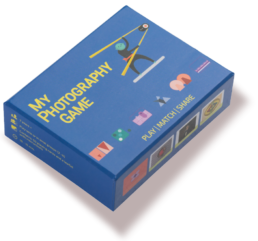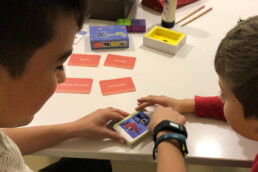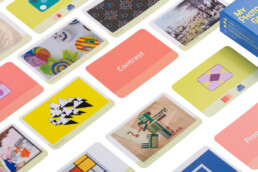
A visual challenge in the shape of a quartet game
One of the 21st century skills on literacy directs to the mediated surrounding. Practicing to understand how images are made, what they mean, or how they create emotions and generate impact is crucial. My Photography Game helps to unravel the visual elements in photographs, paintings and illustrations
Adults and children practicing to understand how images are constructed and how they transmit ideas is a crucial fun activity. My Photography Game is a family card game for identifying how photographs, paintings and illustrations are made.
Look carefully at the images and ask yourself what you see: the types of lines, positions, groups, colors… What do you think the painter/ artist wanted to show or express? How does this image make you feel?
Ages: 7 to 99 | 1 to 6 players.

How to play: Hand a theme pink card to each player. Place the image cards one by one on the table. The players have to recognize if the image belongs to their card. After collecting a quartet, all players stop, check if the quartet is correct, and the player gets a new pink card or goes on. The winner is the player with more quartets. Afterwards, all players choose a favorite theme and take a photograph adding it up.

#myphotogame
Example of cards and authors.
Example for Groups and Areas:
Christine de Pizan, 15th Century.
Christine de Pizan was born in Italy and raised in France. She was a writer and historian that devoted her work to women’s equality already in the middle ages. This miniature belongs to her book “The City of Ladies”. You can read more about her here on the vintagenews website
Example for Central:
Jeptha Homer Wade was a busy man that had factories and made paintings like this one of Nathaniel Olds (1837) that you can see at the Cleveland Museum of Art.The spectacles he wears were to protect against Argand Lamps. If you want to know more about this painting visit clevelandart.org
Example for Proportion
Matrakçi Nasuh, 16th century.
Matrakçı Nasuh was born in Bosnia, was an expert In mathematics and history, and was well known for his miniatures depicting landscapes and cities of 16th-century in Persia. Discover his amazing paintings at the publicdomain archives.
Example for Repetition
Adeline Harris (1856).
Adeline, from Rhode Island, was 17 when she started to make a quilt asking people to sign in small cubes of silk and stitching the 360 signatures to more than 150 different fabrics. If you want to see the cubes in detail visit the publicdomain archives.
Example for Contrast
Beatus Of Facundus (1047).
In the 9th century, in the mountains of northern Spain, a monk named Beatus de Facundus illustrated a collection of writings. His depictions were so beautiful that throughout hundreds of years they would be hand copied over and over again as there was no technology for printing. You can see more beautiful illustrations from him at the publicdomain archives.